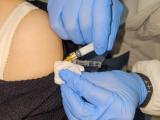Apr 10, 2013 (CIDRAP News) – The US Centers for Disease Control and Prevention (CDC) takes a hit of about $270 million in the Obama administration's proposed fiscal year 2014 budget, including significant cuts to biodefense and emergency preparedness programs, officials revealed today.
CDC Director Tom Frieden, MD, speaking at a Department of Health and Human Services (HHS) press conference, said the "overall program budget would come down by about $270 million" under the budget proposal, compared with spending in fiscal year 2012.
Total spending for fiscal year 2013, which ends Sep 30, has not yet been determined, in the wake of "sequestration" cuts that took effect in March. Richard Hamburg, deputy director of the Trust for America's Health, a nonpartisan advocacy group, said legislation passed in March gave agencies 30 days to present their spending plans for the rest of the fiscal year, and HHS has not yet presented its plan.
"We see the future; we haven't seen the present yet," Hamburg told CIDRAP News. "Any time you're releasing a new budget before spending for the current year is finalized, it makes it a little confusing."
The 2014 HHS budget summary, released today, lists $1.33 billion for CDC biodefense and emergency preparedness activities, down $48 million from the 2012 level. That includes $658 million for Public Health and Emergency Preparedness grants to the states, an $8 million decrease.
Also, the proposed allocation for the Strategic National Stockpile of emergency medical supplies is $510 million, which is $38 million less than in 2012, according to the budget summary. And the listed amount for the CDC's core preparedness and response capability for public health emergencies is $166 million, down by $1 million from 2012.
Not all programs are on the chopping block, however. The proposed budget lists $432 million for "emerging and zoonotic infectious disease activities," which includes $40 million for a new initiative to improve the CDC's technology and methods for responding to disease outbreaks.
"This will allow us o find outbreaks quicker, to find a higher proportion of outbreaks," and improve the ability to learn how they are spreading, Frieden said at the press conference.
The effort is called the Advanced Molecular Detection and Response to Infectious Disease Outbreaks initiative, according to the budget summary. It's being developed in response to a 2011 report from an external panel of experts, who "identified a number of critical gaps in CDC's surveillance capabilities and starkly concluded that CDC was on the path to becoming obsolete, if not irrelevant."
In fiscal year 2014, the CDC will begin work on staff development, infrastructure improvement, partner laboratory development, and planning to disseminate new approaches throughout the agency and to other public health labs, the budget summary says.
Some other increases in the proposal—compared with 2012—are $16 million for global public health, to $393 million, and $287 million for the Vaccines for Children (VFC) Program, to $4.29 billion.
"Overall this is another budget that proposes a cut to the CDC," said Hamburg. "It's always difficult to ascertain the exact amount, but no matter how you look at it, CDC has been cut a couple hundred million dollars."
Hamburg also noted that HHS's Hospital Preparedness Program is targeted for a $119 million cut in the proposed budget, to $255 million, compared with $374 million in 2012. That program is run not by the CDC but by HHS's Office of the Assistant Secretary for Preparedness and Response.
On the other hand, he said, the administration is proposing new spending on pandemic influenza preparedness, apparently for the first time since the 2009 pandemic. "There's a request for $109 million in no-year funding and $32 million in annual funding for 2014," he said.
The money is intended for next-generation antivirals, rapid diagnostic assays, and accelerated development of flu vaccines, Hamburg said. The proposal comes as the CDC is warily watching the spread of H7N9 flu cases in China.
Overall, according to the HHS summary, the proposed CDC budget includes $6.7 billon for the agency's "mission-critical efforts to prevent and control infectious diseases." Of that, $124 million is from the Prevention and Public Health Fund and $4.3 billion is mandatory spending for the VFC program.
The proposed CDC budget was singled out for criticism today by the American Public Health Association (APHA), which put the overall reduction at $430 million, or 7.7% below the 2012 level. In a statement, APHA Executive Director Georges Benjamin, MD, said the cuts would reduce the CDC's budget authority to a lower level than in 2003.
An Associated Press (AP) report today said serious budget negotiations between the Obama administration and Congress are unlikely to come until summer, when the government will need to raise its borrowing limit again.
The administration is proposing an overall 2014 budget of $3.8 trillion, with a projected $973 billon deficit, according to the AP.
See also:
2014 HHS budget landing page
2014 HHS budget summary
Apr 10 APHA press release


















